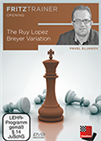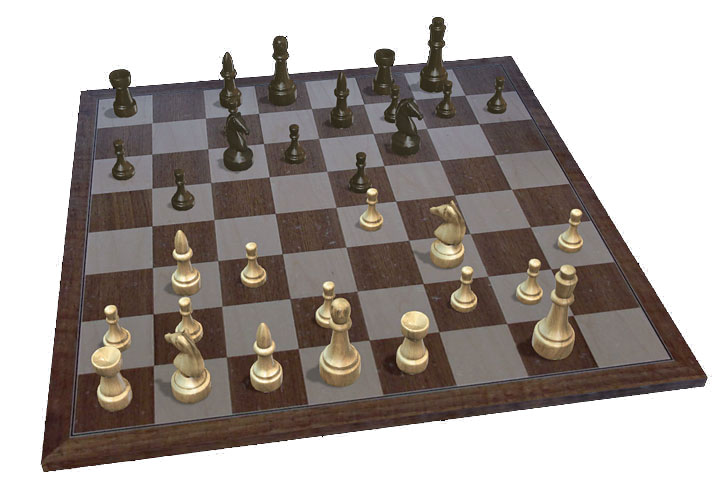Efstratios Grivas: Learn to play the Ruy Lopez
This is a unique trial balloon. In the following commentary by renown trainer Efstratios Grivas, you will find special "diagrams" — they are actually replay boards in which you can practice what the grandmaster is telling you in his text commentary. You can pick an electronic opponent that matches your playing strength, and try alternate continuations from the given position.
In the windows below you have buttons for a number of functions: (From left to right) New game, Take back move, Play move forwards, Play now, Get hint, Very weak opponent, Serious amateur, Club player, Master, Switch colours, analyse with a chess engine.

Hover over the buttons in the actual toolbar below to see their function
Choose an opponent to match your playing strength and try your luck with the Ruy Lopez. This is a good way to prepare for your next beach game, a more serious encounter, your next club tournament, or the international GM event.
The Ruy Lopez [C92] — Analysis by Efstratios Grivas, Athens 14.06.2018
1.e4 e5 2.Nf3 Nc6 3.Bb5
This is often called the ‘Spanish Defence’ or ‘Ruy Lopez’, as it is named after the 16th-century Spanish bishop Ruy López de Segura, after it appeared in his 1561 book. It is one of the most popular openings, with such a vast number of variations that in the Encyclopaedia of Chess Openings (ECO) all codes from C60 to C99 are assigned to them. It's a solid defence which, however, requires a lot of theoretical knowledge. In the main lines, it can lead to strategically challenging positions for both sides, requiring good strategical knowledge, mixed with a tactical eye.
 Pavel Eljanov explains in depth what Gyula Breyer already saw in 1911 and what became an opening choice of the likes of Kasparov, Kramnik, Anand or Carlsen. The Breyer Variation, which is characterised by the knight retreat to b8.
Pavel Eljanov explains in depth what Gyula Breyer already saw in 1911 and what became an opening choice of the likes of Kasparov, Kramnik, Anand or Carlsen. The Breyer Variation, which is characterised by the knight retreat to b8.Play here against an engine of your choice, following the advice of the GM below
3...a6. In the last 20 years, Black tried often to play without this move, going for the immediate 3...Nf6, which leads to the fashionable ‘Berlin or Ant-Berlin Defences’, depending on what White will choose. After 4.0–0 (4.d3 is also fashionable) 4...Nxe4 5.d4 Nd6 6.Bxc6 dxc6 7.dxe5 Nf5 8.Qxd8+ Kxd8.
 In this DVD Sam Collins provides a complete and detailed repertoire for Black. Numerous novelties and improvements are suggested, with the conclusion that White has no clear route to an opening advantage.
In this DVD Sam Collins provides a complete and detailed repertoire for Black. Numerous novelties and improvements are suggested, with the conclusion that White has no clear route to an opening advantage.Play here against an engine of your choice, following the advice of the GM below
We have the main position of the ‘Berlin Defence’, which caused so many ‘troubles’ for World Champion Garry Kasparov, in the famous match Kasparov-Kramnik, London 2000. He didn’t succeed in breaking the ‘Berlin Wall’, losing the match in the end…
Back to the main line: 1.e4 e5 2.Nf3 Nc6 3.Bb5 a6 4.Ba4. 4.Bxc6 leads to the 'Exchange Ruy Lopez', a favourite 'weapon' of the great Bobby Fischer. After 4...dxc6 5.0–0 (5.Nxe5 Qd4 regains the pawn for Black - 5.d4 is another option) 5...f6 we have another 'heavy' analysed position. Of course Black can choose in-between other moves than 5...f6. 4...Nf6 5.0–0. 5.Qe2 or 5.d3, are quite playable moves as well and shouldn't be underestimated – the rich possibilities of the 'Ruy Lopez' are quite obvious! 5...Be7.
A well-known and often played deviation here is 5...Nxe4, which leads to the so-called ‘Open Ruy Lopez’. White regains his pawn after 6.d4 b5 7.Bb3 d5 8.dxe5 Be6
Play here against an engine of your choice, following the advice of the GM below
With rich play for both sides but with a different kind of battle. White will try to advance his kingside pawn majority (f4), while Black will mainly focus in his own queenside/centre pawn majority, by trying to succeed in playing …c5 and …d4 in general.
6.Re1. White is 'obliged' to protect his central and powerful pawn! 6...b5. Accurate. White will have an extra tempo after 6...d6?! 7.c3 b5 8.Bc2!. 7.Bb3 d6. Another fashionable way for Black is 7...0-0 8.c3 (8.a4 is often played here as well avoiding the Gambit) 8...d5 which leads to the 'Ruy Lopez - Marshall Gambit'. After 9.exd5 Nxd5 10.Nxe5 Nxe5 11.Rxe5 practice has proved that Black retains fair compensation for his sacrificed pawn, due to his better development and initiative to be taken in the kingside.
8.c3 0-0 9.h3.
 The Open Ruy Lopez gives Black free piece play and chances for the initiative. This sharp and interesting variation has been used by many of the all-time greats, including Anand, Kortschnoi, Botvinnik, Keres, Euwe, Fine and Reshevsky and this is by no means an exhaustive list. White will argue that Black loosens his position in the Open Variation, but if Black takes the time and trouble to learn the ideas and tactical themes that underpin this line, he has every chance to win the game. This will be especially interesting to the club player as it doubtless has been to the grandmasters mentioned above.
The Open Ruy Lopez gives Black free piece play and chances for the initiative. This sharp and interesting variation has been used by many of the all-time greats, including Anand, Kortschnoi, Botvinnik, Keres, Euwe, Fine and Reshevsky and this is by no means an exhaustive list. White will argue that Black loosens his position in the Open Variation, but if Black takes the time and trouble to learn the ideas and tactical themes that underpin this line, he has every chance to win the game. This will be especially interesting to the club player as it doubtless has been to the grandmasters mentioned above.Play here against an engine of your choice, following the advice of the GM below
The main line is one of the great classical openings in chess. White has prepared the advance of his d-pawn in the centre by nine moves of careful play. Black has different replies here which all lead to rich and complex positions. The main line has been extensively analysed in the last 100 years or so. It remains strategically interesting and is used by players of all levels.
One of the main questions should be why White plays 9.h3? Well, this move is indirectly ‘strengthens’ the d4-advance, stopping the potential …Bg4 pin: 9.d4 Bg4 and here we have a theoretical battle as well.
9...Na5. The most chosen response, which is named 'Chigorin Variation'. Black's next popular choices are 9...Bb7 (Zaitsev Variation) and 9...Nb8 (Breyer Variation). But Black can choose in-between another 6-7 decent alternatives.
Were you able to beat the program in the lines given above? If you were you should try the next-higher level – click the New Game button on the left of the ribbon and the program will jump back to the end of the variation we are learning. Keep doing this to try alternate continuations. You will find that your are learning the ideas behind the Ruy Lopez, and that this will help you in your games against human opponents. Here's the full commentary by Efstratios Grivas on a replay board where you can analyse with machine support (click on the fan button to start the engine).

[Event "CB - Analysis"] [Site "Athens"] [Date "2018.06.14"] [Round "?"] [White "Ruy Lopez"] [Black "?"] [Result "*"] [ECO "C92"] [Annotator "Efstratios Grivas"] [PlyCount "18"] [EventDate "2018.06.14"] [EventCountry "GRE"] [SourceVersionDate "2018.06.14"] 1. e4 e5 2. Nf3 Nc6 3. Bb5 {(D) [#] This is often called the ‘Spanish Defence’ or ‘Ruy Lopez’, as it is named after the 16th-century Spanish bishop Ruy López de Segura, after it appeared in his 1561 book. It is one of the most popular openings, with such a vast number of variations that in the Encyclopaedia of Chess Openings (ECO) all codes from C60 to C99 are assigned to them. It's a solid defence which, however, requires a lot of theoretical knowledge. In the main lines it can lead to strategically challenging positions for both sides, requiring good strategical knowledge, mixed with a tactical eye.} a6 {(D) [#]} ({In the last 20 years Black tried often to play without this move, going for the immediate} 3... Nf6 {, which leads to the fashionable ‘Berlin or Ant-Berlin Defences’, depending on what White will choose. After} 4. O-O (4. d3 {is also fashionable}) 4... Nxe4 5. d4 Nd6 6. Bxc6 dxc6 7. dxe5 Nf5 8. Qxd8+ Kxd8 {(D) [#] We have the main position of the ‘Berlin Defence’, which caused so many ‘troubles’ for World Champion Garry Kasparov, in the famous match Kasparov-Kramnik, London 2000. He didn’t succeed breaking the ‘Berlin Wall’, and lost the match in the end…}) 4. Ba4 (4. Bxc6 {leads to the 'Exchange Ruy Lopez', a favourite 'weapon' of the great Bobby Fischer. After} dxc6 5. O-O (5. Nxe5 Qd4 {regains the pawn for Black -}) (5. d4 {is another option}) 5... f6 {(D) [#] We have another 'heavily' analysed position. Of course Black can choose in-between moves other than 5...f6.}) 4... Nf6 5. O-O {(D) [#]} (5. Qe2 {or}) (5. d3 {, are quite playable moves as well and shouldn't be underestimated - the rich possibilities of the 'Ruy Lopez' are quite obvious!}) 5... Be7 ({A well-known and often played deviation here is} 5... Nxe4 {, which leads to the so-called ‘Open Ruy Lopez’. White regains his pawn after} 6. d4 b5 7. Bb3 d5 8. dxe5 Be6 {(D) [#] With rich play for both sides but with a different kind of battle. White will try to advance his kingside pawn majority (f4), while Black will mainly focus in his own queenside/centre pawn majority, by trying to succeed in playing …c5 and …d4 in general.}) 6. Re1 {(D) [#] White is 'obliged' to protect his central and powerful pawn!} b5 ({Accurate. White will have an extra tempo after} 6... d6 $6 7. c3 b5 8. Bc2 $1 {.}) 7. Bb3 d6 ({Another fashionable way for Black is} 7... O-O 8. c3 (8. a4 {is often played here as well avoiding the Gambit}) 8... d5 {(D) [#] Which leads to the 'Ruy Lopez - Marshall Gambit'. After} 9. exd5 Nxd5 10. Nxe5 Nxe5 11. Rxe5 {(D) [#] Practice has proved that Black retains fair compensation for his sacrificed pawn, due to his better development and initiative to be taken in the kingside.}) 8. c3 O-O 9. h3 {(D) [#] The main line is one of the great classical openings in chess. White has prepared the advance of his d-pawn in the centre by nine moves of careful play. Black has different replies here which all lead to rich and complex positions. The main line has been extensively analysed in the last 100 years or so. It remains strategically interesting and is used by players of all levels.} ({One of the main questions should be why White plays 9.h3? Well, this move is indirectly ‘strengthens’ the d4-advance, stopping the potential …Bg4 pin:} 9. d4 Bg4 {and here we have a theoretical battle as well.}) 9... Na5 ({The most chosen response, which is named 'Chigorin Variation'. Black's next popular choices are} 9... Bb7 {(Zaitsev Variation)}) ( {and} 9... Nb8 {(Breyer Variation). But Black can choose in-between another 6-7 decent alternatives.}) *
Tell us what you think in the comments or via the "feedback to the editors" link below.

Efstratios Grivas (30.03.1966) is a highly experienced chess trainer and chess author. He has been awarded by the International Chess Federation (FIDE) the titles of International Chess Grandmaster, FIDE Senior Trainer, International Chess Arbiter and International Chess Organiser.
His main successes over the board are the Silver Medal Olympiad 1998 (3rd Board), the Gold Medal European Team Championship 1989 (3rd Board) and the 4th Position World Junior Championship U.20 1985. He has also won 5 Balkan Medals (2 Gold - 1 Silver - 2 Bronze) and he was 3 times Winner of the International ‘Acropolis’ Tournament. He has also in his credit the 28 times first position in Greek Individual & Team Championships and he has won various international tournaments as well. He was also been awarded six FIDE Medals in the Annual FIDE Awards (Winner of the FIDE Boleslavsky Medal 2009 & 2015 (best author) - Winner of the FIDE Euwe Medal 2011 & 2012 & 2017 (best junior trainer) - Winner of the FIDE Razuvaev Medal 2014 (Trainers’ education) and has been a professional Lecturer at FIDE Seminars for Training & Certifying Trainers. He has published a large number of Books & DVDs in Arabic, English, Greek, Italian, Spanish & Turkish languages. Since 2009 he is the Secretary of the FIDE Trainers’ Commission and since 2012 the Director of the FIDE Grivas Chess International Academy (Athens).

Grivas has, to date, produced four Fritztrainer DVDs for ChessBase.



























